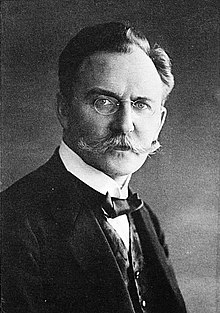Hermann Theodor Simon

Hermann Theodor Simon (born January 1, 1870 in Kirn , † December 22, 1918 in Göttingen ) was a German physicist.
Life
He studied in Heidelberg and Berlin with Heinrich Rubens and August Kundt († May 1894), where he earned his doctorate in 1894 with a thesis on the dispersion of UV radiation . He initially became Eilhard Wiedemann's assistant in Erlangen and completed his habilitation in 1896.
In 1897 in Göttingen he observed the superposition of alternating currents over direct current and in 1898 he invented the singing arc lamp , a kind of radiophonic instrument . ( William Duddell may have invented his singing arc as early as 1894, but only introduced it in 1900.) The arc lamp emits undamped oscillations. The direct current feeding the arc replaces the power lost through heat and radiation. In the following year he discovered that the arc is so sensitive to fluctuations in the air around it that it even follows the small vibrations of the air produced by the human voice and can be used successfully as a microphone.
In 1898 Eduard Riecke brought him to Göttingen as his assistant . From October 1899 they published the Physikalische Zeitschrift and Simon took over the editing until 1904.
In 1899 he and Max Reich invented a radio telephony system in which a selenium receiver activates a talking arc lamp.
At Easter 1900 he went to Frankfurt am Main as a lecturer in physics at the Physikalischer Verein and director of the Physikalisches Institut. In autumn 1901 he returned to Göttingen and became an associate professor and director of the department for applied electricity theory (which Theodor des Coudres had built up since 1895).
In December 1905 the new building was completed and the department was converted into its own institute. In 1907 he became a full professor.
Around 1909 he suggested the establishment of the radio-electrical research institute for navy and army in Göttingen, which was then set up by Max Reich.
After his death, Max Reich succeeded him.
Simon had been a member of the Corps Suevia Heidelberg from the beginning of his studies in Heidelberg .
Fonts
- About dispersion of ultraviolet rays. 1894.
- About a new photographic photometric process and its application. 1896.
- The Carl Simon Sons company 1857 * 1907. 1907.
- The electric arc - experimental lecture held on January 11, 1911 at the request of the Berlin Scientific Association . 1911.
- Life and science, science and life. 1918.
literature
- Armin Danco: The Yellow Book of the Corps Suevia zu Heidelberg, 3rd edition (members 1810–1985), Heidelberg 1985, No. 769
Web links
- Literature by and about Hermann Theodor Simon in the catalog of the German National Library
Individual evidence
- ^ Jagdish Mehra, Helmut Rechenberg: The historical development of quantum theory. Springer, New York 1982, p. 271.
- ↑ BERZELIUS TREE. (PDF; 5 kB)
- ↑ Ludwig Darmstaedter: Handbook on the history of natural sciences and technology. In chronological representation. (PDF; 2.5 MB) 2., redesigned. u. Probably edition, with the participation of R. du Bois-Reymond, edited by L. Darmstaedter, Singer, Berlin 1908, p. 971.
- ↑ Timeline from 1800–1899. 1897 on: deutsches-telefon-museum.eu
- ↑ Berthold Monasch: The electric arc with direct current and alternating current and its applications. Springer, Berlin 1904.
- ↑ Ludwig Darmstaedter: Handbook for the history of natural sciences…. (PDF; 2.8 MB) p. 980.
- ↑ Personnel file Prof. Dr. Hermann Theodor Simon (physicist, 1870–1918). (PDF; 4.1 MB) In: U. Hunger, H. Wellenreuther: Schriften des Universitätsarchiv Göttingen. Volume 1, Göttingen 2002, p. 107f.
- ↑ Personnel file Prof. Dr. Max Reich. (PDF; 4.1 MB) In: U. Hunger, H. Wellenreuther: Schriften des Universitätsarchiv Göttingen. Volume 1, Göttingen 2002, p. 95.
- ↑ Kösener Corpslisten 1960, 67 , 762
- ↑ Detailed chronicle of SIMONA AG. on: simona-de.com
| personal data | |
|---|---|
| SURNAME | Simon, Hermann Theodor |
| BRIEF DESCRIPTION | German physicist |
| DATE OF BIRTH | January 1, 1870 |
| PLACE OF BIRTH | Kirn |
| DATE OF DEATH | December 22, 1918 |
| Place of death | Goettingen |
